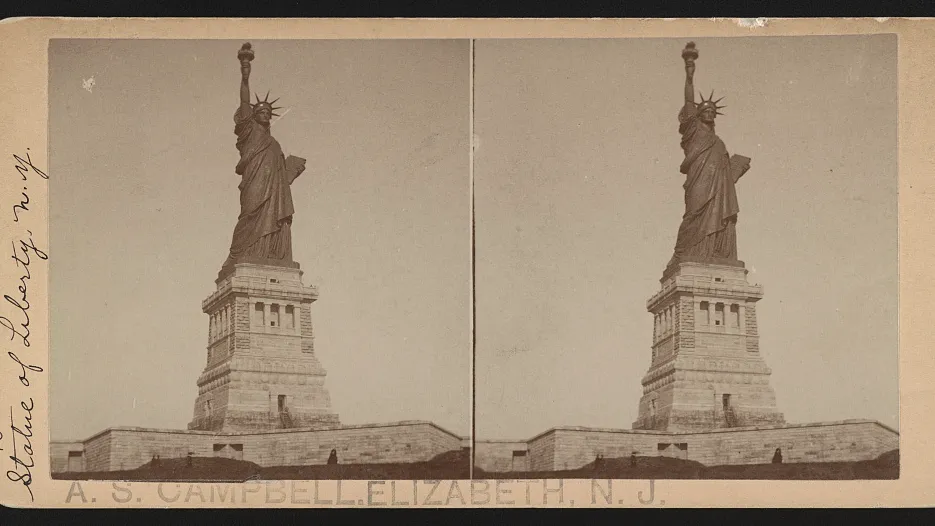Get ready to step back in time to 1886, when the awe-inspiring Statue of Liberty was first revealed to the world. This momentous occasion, met with widespread excitement and fanfare, marked the official dedication of Lady Liberty as a beacon of freedom and a symbol of the enduring bond between France and the United States.
Statue of Liberty Dedication Events
Imagine the scene: October 28th, 1886, a crisp autumn day in New York Harbor. Excitement crackles in the air as a crowd gathers, over a million strong, to witness the grand unveiling of the Statue of Liberty. President Grover Cleveland, dignitaries, and everyday citizens alike stand ready to welcome this incredible gift from the people of France.
But this wasn’t merely a statue unveiling; it was a symbolic act of unity and a testament to shared ideals. Modeled after Libertas, the Roman goddess of liberty and enlightenment, the statue served as a powerful representation of the values upon which both France and the United States were founded. Her torch, held high, symbolized the ever-burning flame of freedom, while the broken chains at her feet represented the triumph over oppression.
What Events Does the Statue of Liberty Commemorate?
The Statue of Liberty stands as a testament to several significant historical events and enduring ideals:
- The Centennial of the Declaration of Independence: France gifted the statue to the U.S. in 1886 to commemorate the 100th anniversary of the signing of the Declaration of Independence, a testament to the shared values of liberty and democracy that bound the two nations together.
- Franco-American Friendship: More than just a birthday gift, the Statue of Liberty embodies the enduring friendship and alliance between France and the United States, forged during the American Revolution and solidified through their shared dedication to the principles of liberty and self-determination.
- The Global Pursuit of Freedom: While initially a symbol of the bond between two nations, the Statue of Liberty has transcended its origins to become a global icon of freedom and hope, welcoming millions of immigrants to American shores and inspiring countless individuals around the world with its message of liberty and opportunity.
The statue itself, with its torch of enlightenment and tablet inscribed with “JULY IV MDCCLXXVI,” serves as a constant reminder of these momentous events and the ideals they represent.
What Was the Dedication of the Statue of Liberty Like?
The dedication of the Statue of Liberty was a grand affair, a spectacle befitting the monument’s scale and symbolism.
Imagine a massive French flag, draped over Lady Liberty’s face, finally falling away to reveal her majestic form. The cheers of the crowd, the booming cannons, the procession of ships – all contributed to a sense of awe and celebration. President Grover Cleveland, addressing the crowd, hailed the statue as a “mighty woman with a torch” and “the Mother of Exiles,” emphasizing its role as a welcoming symbol for immigrants seeking refuge and opportunity in America.
This dedication ceremony, captured in photographs and news accounts, solidified the Statue of Liberty’s place in the world’s imagination, not just as a monument, but as a powerful symbol of freedom, democracy, and the promise of America.
What Day Was the Statue of Liberty Dedicated?
Mark your calendars because this is a date worth remembering! The Statue of Liberty was officially dedicated on October 28, 1886. After years of planning, construction, and transatlantic shipping, Lady Liberty stood complete on her pedestal in New York Harbor.
The dedication ceremony, attended by dignitaries and a massive crowd of onlookers, was a testament to the enduring friendship between France and the United States and a celebration of the ideals of liberty and democracy they shared.
The date, forever etched in history, marks the moment the Statue of Liberty took her rightful place as a symbol of hope, freedom, and the promise of a brighter future.
Does the Statue of Liberty Have Anything to Do with Independence Day?
While not directly linked to the Fourth of July celebrations, the Statue of Liberty embodies many of the values at the heart of Independence Day.
Think of it this way: Independence Day celebrates the birth of a nation, the momentous occasion when the United States declared its freedom. The Statue of Liberty, arriving on American shores nearly a century later, serves as a powerful reminder of the ideals that fueled that fight for independence – liberty, democracy, and the pursuit of happiness.
The statue, with its torch of enlightenment and broken chains of oppression, embodies the very spirit of freedom that the Founding Fathers fought so hard to achieve. For many immigrants, catching their first glimpse of Lady Liberty as they arrived in New York Harbor, the statue became inextricably linked to the promise of America, a land of opportunity and freedom.
What Two Things Does the Statue of Liberty Represent?
The Statue of Liberty, a gift from France, stands as a symbol of:
- Freedom and Democracy: With her torch held high, she represents the light of liberty guiding the way to a brighter future. The broken chains at her feet symbolize breaking free from tyranny, while the tablet in her hand, inscribed with the date of the Declaration of Independence, serves as a reminder of the hard-won fight for freedom.
- Enduring Friendship: The statue stands as a testament to the unique bond between France and the United States, a relationship forged in the fires of revolution and solidified through their shared dedication to the ideals of liberty, democracy, and opportunity.
What are 5 Interesting Facts About the Statue of Liberty?
Beyond its iconic status, the Statue of Liberty holds some fascinating secrets:
- A Centennial Gift: The Statue of Liberty was a gift from the people of France to the United States, commemorating the centennial anniversary of the signing of the Declaration of Independence.
- The Torch’s Transformation: The current torch, shining brightly, is not the original. The first torch, made of copper, was replaced in 1986 with a new gold-plated torch due to wear and tear.
- From Copper Brown to Verdigris Green: The Statue of Liberty wasn’t always green! Originally a dull copper color, the statue’s exterior underwent a natural chemical reaction called patina, transforming it into the iconic verdigris green we know today.
- A Heavyweight Champion: Standing tall at 151 feet and weighing a massive 450,000 pounds, the Statue of Liberty is a true engineering marvel, taller than a 12-story building and as heavy as a herd of elephants.
- More Than Just Copper and Steel: The Statue of Liberty transcends its physical form to embody hope, freedom, and the promise of a better life, especially for the millions of immigrants who saw her as a welcoming symbol upon their arrival in America.
What is the Historical Significance of the Statue of Liberty?
The Statue of Liberty isn’t just a pretty face; she’s a symbol woven into the very fabric of history:
- A Gift of Immense Significance: Presented to the United States by France in 1886, the Statue of Liberty transcended its purpose as a centennial gift to become a symbol of the shared values and aspirations of both nations.
- A Beacon for Immigrants: Standing tall in New York Harbor, the statue became a symbol of hope and opportunity for the millions of immigrants who arrived in the United States seeking a better life, representing the promise of freedom and a fresh start.
- An Enduring Emblem of Freedom: Her image, instantly recognizable around the world, has become synonymous with the ideals of liberty, democracy, and the pursuit of happiness, inspiring countless individuals with its message of hope.
However, the story of the Statue of Liberty continues to unfold. Ongoing research, particularly regarding the statue’s symbolism in the context of abolitionism and the Civil War, suggests that there are still layers of meaning to be uncovered.
What Occasion Was the Statue of Liberty a Gift to Celebrate?
The Statue of Liberty was a gift to the United States from France in celebration of the centennial anniversary of the signing of the Declaration of Independence. This momentous occasion, marked by the dedication of the statue on October 28, 1886, signified the strong bond between the two nations and their shared commitment to the ideals of liberty and democracy.
The gift, conceived by French historian Édouard de Laboulaye, was intended to honor the United States’ accomplishment of achieving and maintaining its independence for a century and to recognize the crucial role France played in supporting the American Revolution.
How Often Does the Statue of Liberty Get Struck by Lightning?
Standing tall and proud in New York Harbor, the Statue of Liberty is a prime target for lightning. Some experts estimate that she experiences about 25 lightning strikes each year, particularly during the summer storm season.
However, fear not for Lady Liberty! Her copper exterior, while an excellent conductor of electricity, acts as a giant lightning rod, channeling the electric current down to a robust grounding system below. So, while a lightning strike might create a dramatic spectacle, the statue is engineered to withstand these electrifying encounters.
On What Occasion Did the French Government Give the Statue of Liberty to the USA?
The French government officially presented the Statue of Liberty to the United States in 1884, although its journey across the Atlantic was completed in pieces – 350 to be exact. It took four months to reassemble Lady Liberty on her pedestal on what was then called Bedloe’s Island, later renamed Liberty Island.
This momentous gift, a symbol of Franco-American friendship and a celebration of the United States’ centennial of independence, solidified the bond between the two nations and served as a beacon of hope and opportunity for generations to come.
Prepare to be captivated by the Yorktown Parade Day and Liberty Statue Ceremony, where colonial charm and maritime heritage intertwine. And don’t miss the Yorktown Victory Celebrations, commemorating one of the most decisive battles in American history.

![[France Powerball History Results] Unveiled: A Journey Through Decades of Fortune france-powerball-history-results_2](https://www.lolaapp.com/wp-content/uploads/2023/12/france-powerball-history-results_2-150x150.jpg)














